A Novel Acoustic Sandwich Panel Based on Sheep Wool
Abstract
1. Introduction
2. Materials and Methods
2.1. Materials
2.2. Preparation of Samples
2.3. Methods of Determination
3. Results and Discussion
3.1. Sound Absorption
3.2. Airborne Sound Insulation
3.3. Thermal Conductivity and Thermal Resistance
3.4. Compressive Strength
3.5. Bending Strength
4. Conclusions
- The sound absorption of the sandwich panel depends on the ratio of skin perforations. The maximum values vary between 0.708–0.903, which are very high values in the category of natural sandwich composites;
- The measured weighted sound reduction index of the panel was of 38 dB;
- Thermal conductivity of the sandwich panel (0.07699 W/m·K) was low;
- Mechanical strength of the panels was comparable to the reported values in the literature (compressive strength of 0.208 MPa and bending strength of 0.042 MPa), considering that only natural materials were used in the manufacturing process of the panels.
Author Contributions
Funding
Conflicts of Interest
References
- Krus, M.; Theuerkorn, W.; GroBinski, T.; Künzel, H. New sustainable and insulating building material made of cattail. Full Pap. NSB 2014, 1252–1260. [Google Scholar]
- Faustino, J.; Pereira, L.; Soares, S.; Cruz, D.; Paiva, A.; Varum, H.; Ferreira, J.; Pinto, J. Impact sound insulation technique using corn cob particleboard. Constr. Build. Mater. 2012, 37, 153–159. [Google Scholar] [CrossRef]
- Mishra, S.P.; Nath, G. Synthesis and analysis of acou-physical properties of banana biocomposite. In Proceedings of the IOP Conference Series: Materials Science and Engineering, Istanbul, Turkey, 8 August 2018; IOP Publishing: Bristol, UK, 2018; Volume 310. [Google Scholar]
- Kinnane, O.; Reilly, A.; Grimes, J.; Pavia, S.; Walker, R. Acoustic absorption of hemp-lime construction. Constr. Build. Mater. 2016, 122, 674–682. [Google Scholar] [CrossRef]
- Trematerra, A.; Antonio, M.; Iannace, G. Use of green material for acoustic correction inside rooms. J. Sustain. Archit. Civ. Eng. 2013, 3, 33–38. [Google Scholar] [CrossRef]
- Faruk, O.; Bledzki, A.K.; Fink, H.-P.; Sain, M. Biocomposites reinforced with natural fibers: 2000–2010. Prog. Polym. Sci. 2012, 37, 1552–1596. [Google Scholar] [CrossRef]
- Kymäläinen, H.-R.; Sjöberg, A.-M. Flax and hemp fibres as raw materials for thermal insulations. Build. Environ. 2008, 43, 1261–1269. [Google Scholar] [CrossRef]
- Genc, G.; Koruk, H. Identification of the dynamic characteristics of luffa fiber reinforced bio-composite plates. Bioresources 2017, 12, 5358–5368. [Google Scholar] [CrossRef][Green Version]
- D’Alessandro, V.; Petrone, G.; Franco, F.; De Rosa, S. A review of the vibroacoustics of sandwich panels: Models and experiments. J. Sandw. Struct. Mater. 2013, 15, 541–582. [Google Scholar] [CrossRef]
- Prabhakaran, S.; Krishnaraj, V.; Shankar, K.; Senthilkumar, M.; Zitoune, R. Experimental investigation on impact, sound, and vibration response of natural-based composite sandwich made of flax and agglomerated cork. J. Compos. Mater. 2019. [Google Scholar] [CrossRef]
- Sargianis, J.J.; Kim, H.I.; Andres, E.; Suhr, J. Sound and vibration damping characteristics in natural material based sandwich composites. Compos. Struct. 2013, 96, 538–544. [Google Scholar] [CrossRef]
- Zhang, J.; Shen, Y.; Jiang, B.; Li, Y. Sound absorption characterization of natural materials and sandwich structure composites. Aerospace 2018, 5, 75. [Google Scholar] [CrossRef]
- Sargianis, J.; Kim, H.I.; Suhr, J. Natural cork agglomerate employed as an environmentally friendly solution for quiet sandwich composites. Sci. Rep. 2012, 2, 403. [Google Scholar] [CrossRef] [PubMed]
- Bach, M.R.; Chalivendra, V.B.; Alves, C.; Depina, E. Mechanical characterization of natural biodegradable sandwich materials. J. Sandw. Struct. Mater. 2017, 19, 482–496. [Google Scholar] [CrossRef]
- Cosereanu, C.; Lica, D.; Curtu, I.; Lunguleasa, A.; Cismaru, I.; Brenci, L.M.; Fotin, A. Mechanical testing of beech veneer sandwich composites. In Proceedings of the 7th International Conference of DAAAM Baltic Industrial Engineering, Tallinn, Estonia, 22–24 April 2010; pp. 0417–0422. [Google Scholar]
- Ude, A.U.; Ariffin, A.K.; Azhari, C.H. An experimental investigation on the response of woven natural silk fiber/epoxy sandwich composite panels under low velocity impact. Fibers Polym. 2013, 14, 127–132. [Google Scholar] [CrossRef]
- Dhas, E.R.; Pradeep, P. Mechanical property evaluation of palm/glass sandwiched fiber reinforced polymer composite in comparison with few natural composites. In Proceedings of the IOP Conference Series: Materials Science and Engineering, Bali, Indonesia, 1–2 April 2016; IOP Publishing: Bristol, UK, 2017; Volume 247, p. 012010. [Google Scholar]
- Pandita, S.D.; Yuan, X.; Manan, M.A.; Lau, C.H.; Subramanian, A.S.; Wei, J. Evaluation of jute/glass hybrid composite sandwich: Water resistance, impact properties and life cycle assessment. J. Reinf. Plast. Compos. 2014, 33, 14–25. [Google Scholar] [CrossRef]
- Fajrin, J.; Zhuge, Y.; Bullen, F.; Wang, H. Flexural behaviour of hybrid sandwich panel with natural fiber composites as the intermediate layer. J. Mech. Eng. Sci. 2016, 10, 1968–1983. [Google Scholar] [CrossRef]
- Fajrin, J.; Zhuge, Y.; Bullen, F.; Wang, H. The structural behavior of hybrid structural insulated panels under pure bending load. Int. J. Technol. 2017, 8, 777–788. [Google Scholar] [CrossRef]
- Brenci, L.M.; Cosereanu, C.; Zeleniuc, O.; Georgescu, S.V.; Fotin, A. Thermal conductivity of wood with ABS waste core sandwich composites subject to various core modifications. BioResources 2018, 13, 555–568. [Google Scholar] [CrossRef]
- Buratti, C.; Belloni, E.; Merli, F.; Zanella, V.; Robazza, P.; Cornaro, C. An innovative multilayer wall composed of natural materials: Experimental characterization of the thermal properties and comparison with other solutions. Energy Procedia 2018, 148, 892–899. [Google Scholar] [CrossRef]
- La Rosa, A.D.; Recca, A.; Gagliano, A.; Summerscales, J.; Latteri, A.; Cozzo, G.; Cicala, G. Environmental impacts and thermal insulation performance of innovative composite solutions for building applications. Constr. Build. Mater. 2014, 55, 406–414. [Google Scholar] [CrossRef]
- Ricciardi, P.; Belloni, E.; Cotana, F. Innovative panels with recycled materials: Thermal and acoustic performance and Life Cycle Assessment. Appl. Energy 2014, 134, 150–162. [Google Scholar] [CrossRef]
- Balador, Z.; Gjerde, M.; Isaacs, N.; Whitburn, S. Research hotspots on agro-waste based building insulation products—A meta-review. In Proceedings of the SB-LAB 2017, Porto, Portugal, 15–17 November 2017. [Google Scholar]
- Nguyen, D.M.; Grillet, A.-C.; Diep, T.M.H.; Bui, Q.B.; Woloszyn, M. Influence of thermo-pressing conditions on insulation materials from bamboo fibers and proteins based bone glue. Ind. Crops Prod. 2018, 111, 834–845. [Google Scholar] [CrossRef]
- Dénes, T.-O.; Tămaş-Gavrea, D.-R. Mechanical properties of lime based composites. Procedia Manuf. 2019, in press. [Google Scholar]
- Tămaş-Gavrea, D.-R.; Dénes, T.-O. Mechanical, thermal, and acoustical properties of an innovative lime-wool composite. Procedia Manuf. 2019, in press. [Google Scholar]
- SR EN ISO 10534-2:2002. Acoustics—Determination of Sound Absorption Coefficient and Impedance in Impedances Tubes—Part 2: Transfer-Function Method (ISO 10534-2:1998); ISO: Geneva, Switzerland, 2002. [Google Scholar]
- ASTM Standard C423. Standard Test Method for Sound Absorption and Sound Absorption Coefficients by the Reverberation Room Method; ASTM: West Conshohocken, PA, USA, 2017. [Google Scholar]
- SR EN ISO 10140-2:2011. Acoustics—Laboratory Measurement of Sound Insulation of Building Elements—Part 2: Measurement of Airborne Sound Insulation; ISO: Geneva, Switzerland, 2011. [Google Scholar]
- SR EN ISO 717-1:2013. Acoustics—Rating of Sound Insulation in Buildings and of Building Elements—Part 1: Airborne Sound Insulation; ISO: Geneva, Switzerland, 2013. [Google Scholar]
- SR EN 12664:2002. Thermal Performance of Building Materials and Products. Determination of Thermal Resistance by Means of Guarded Hot Plate and Heat Flow Meter Methods. Dry and Moist Products of Medium and Low Thermal Resistance; CEN: Brussels, Belgium, 2002. [Google Scholar]
- SR EN 826:2013. Thermal Insulating Products for Building Applications—Determination of Compression Behaviour; CEN: Brussels, Belgium, 2013. [Google Scholar]
- SR EN 12089:2013. Thermal insulating Products For Building Applications—Determination of Bending Behaviour; CEN: Brussels, Belgium, 2013. [Google Scholar]
- Absorption Coefficients. Available online: http://www.acoustic.ua/st/web_absorption_data_eng.pdf (accessed on 7 January 2020).
- Zulkifli, R.; Mohd Nor, M.J.; Mat Tahir, M.F.; Ismail, A.R.; Nuawi, M.Z. Acoustic properties of multi-layer coir fibres sound absorption panel. J. Appl. Sci. 2008, 8, 3709–3714. [Google Scholar] [CrossRef]
- Huang, C.-H.; Lin, J.-H.; Lou, C.-W.; Tsai, Y.-T. The efficacy of coconut fibers on the sound-absorbing and thermal-insulating nonwoven composite board. Fibers Polym. 2013, 14, 1378–1385. [Google Scholar] [CrossRef]
- Wang, T.; Ge, H.; Wang, F. The sound absorption of sisal fiber and sisal fiber/polyethylene film sheets: Morphology and structure. Polym. Compos. 2018, 39, 2812–2818. [Google Scholar] [CrossRef]
- Díaz, C.; Jiménez, M.; Navacerrada, M.Á.; Pedrero, A. Acoustic properties of reed panels. Mater. Constr. 2012, 62, 55–66. [Google Scholar] [CrossRef]
- C125-2013. Normativ Privind Acustica în Construcţii şi Zone Urbane; MDRAP: Bucharest, Romania, 2013. [Google Scholar]
- C107/2-2005. Normativ Privind Calculul Termotehnic al Elementelor de Construcţie ale Clădirilor. Partea a 2-a: Normativ Privind Calculul Coeficienţilor Globali de Izolare Termică la Clădirile cu Altă Destinaţie Decât cea de Locuire; MDRAP: Bucharest, Romania, 2005. [Google Scholar]
- Asdrubali, F.; D’Alessandro, F.; Schiavoni, S. A review of unconventional sustainable building insulation materials. Sustain. Mater. Technol. 2015, 4, 1–17. [Google Scholar] [CrossRef]
- Efe, F.T.; Alma, M.H. Investigating some physical properties of composite board, produced from sunflower stalks, designed horizontally. Ekoloji Derg. 2014, 23, 40–48. [Google Scholar] [CrossRef]
- Binici, H.; Eken, M.; Dolaz, M.; Aksogan, O.; Kara, M. An environmentally friendly thermal insulation material from sunflower stalk, textile waste and stubble fibres. Constr. Build. Mater. 2014, 51, 24–33. [Google Scholar] [CrossRef]
- Schiavoni, S.; D’Alessandro, F.; Bianchi, F.; Asdrubali, F. Insulation materials for the building sector: A review and comparative analysis. Renew. Sustain. Energy Rev. 2016, 62, 988–1011. [Google Scholar] [CrossRef]
- Ammayappan, L. Eco-friendly surface modifications of wool fiber for its improved functionality: An overview. Asian J. Text. 2013, 3, 15–28. [Google Scholar] [CrossRef]
- Ye, Z.; Wells, C.M.; Carrington, C.G.; Hewitt, N.J. Thermal conductivity of wool and wool-hemp insulation. Int. J. Energy Res. 2006, 30, 37–49. [Google Scholar] [CrossRef]
- Buska, A.; Mačiulaitis, R. The compressive strength properties of mineral wool slabs: Influence of structure anisotropy and methodical factors. J. Civ. Eng. Manag. 2007, 13, 97–106. [Google Scholar] [CrossRef]
- Yang, F.; Fei, B.; Wu, Z.; Peng, L.; Yu, Y. Selected properties of corrugated particleboards made from bamboo waste (Phyllostachys edulis) laminated with medium-density fiberboard panels. BioResources 2014, 9, 1085–1096. [Google Scholar] [CrossRef][Green Version]
- Technical Data. Available online: https://www.austrotherm.ro/descarcari/cataloage/ (accessed on 8 January 2020).
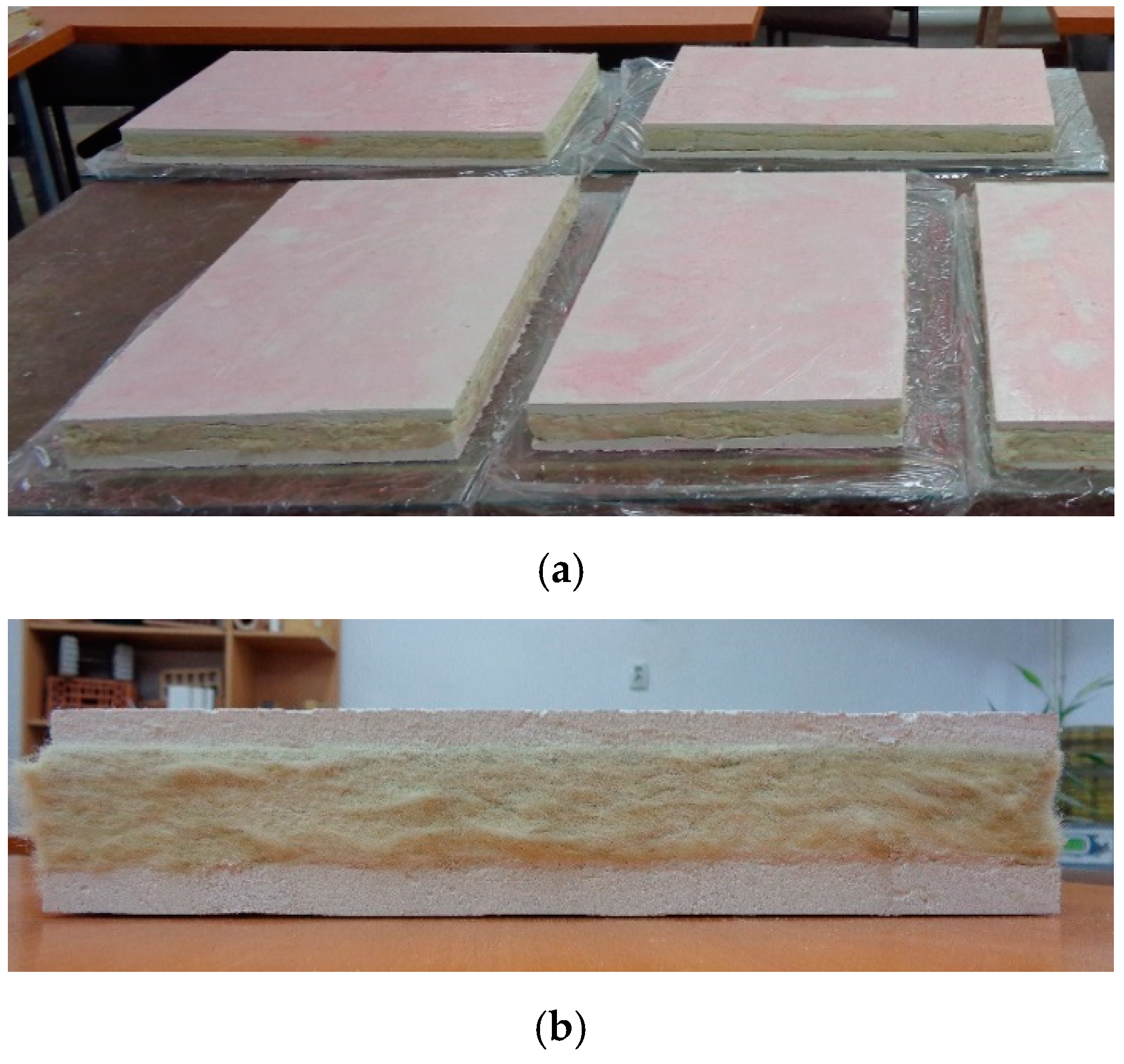
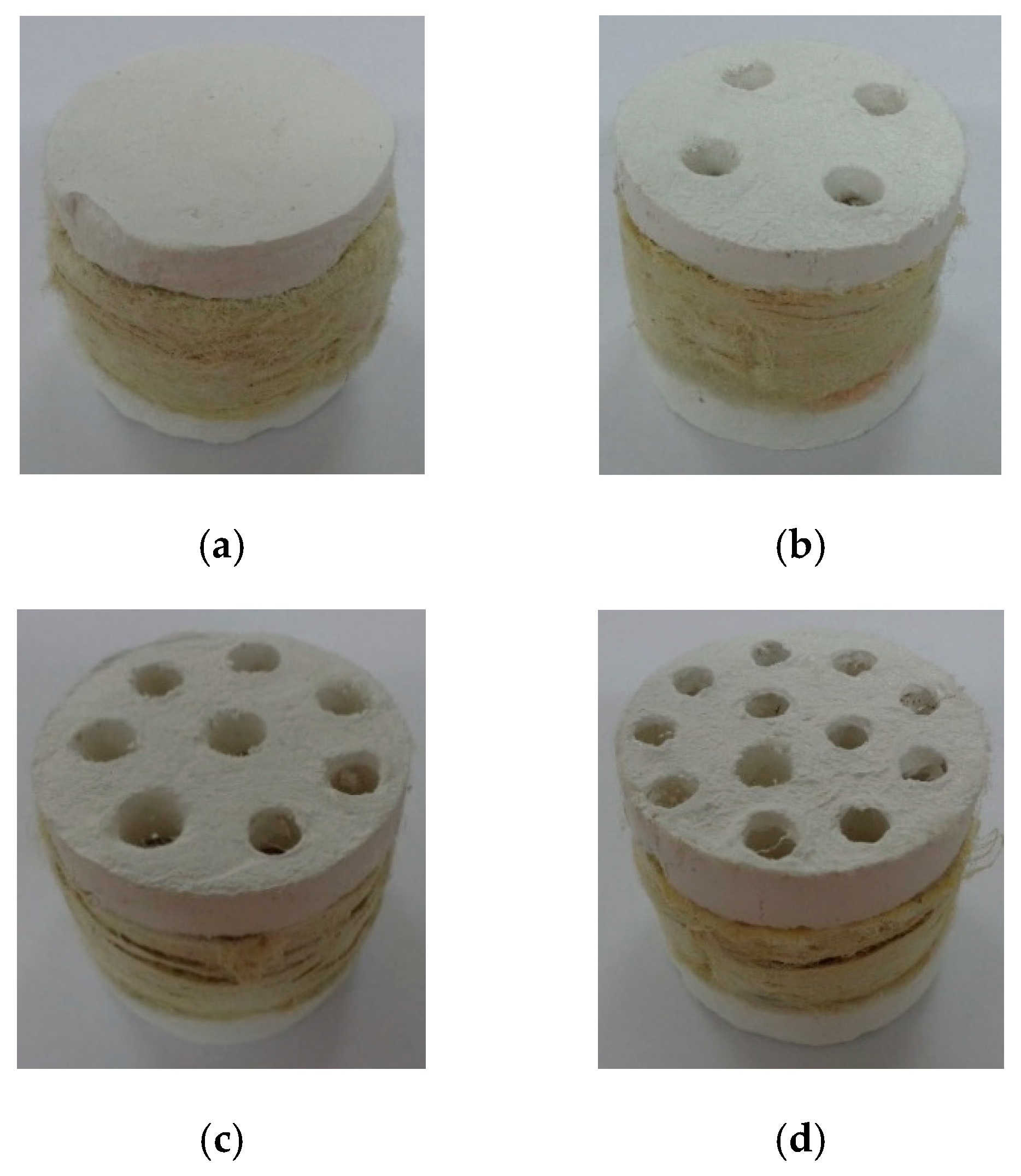
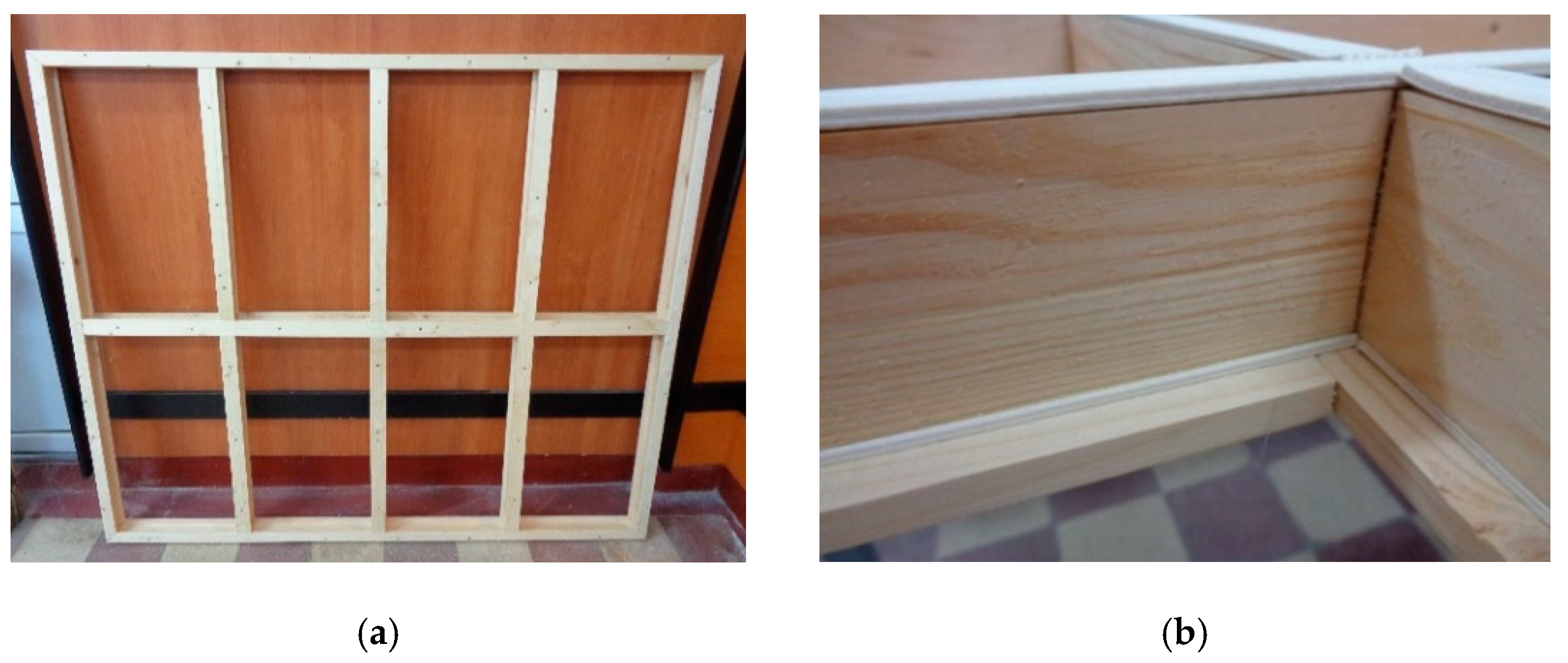

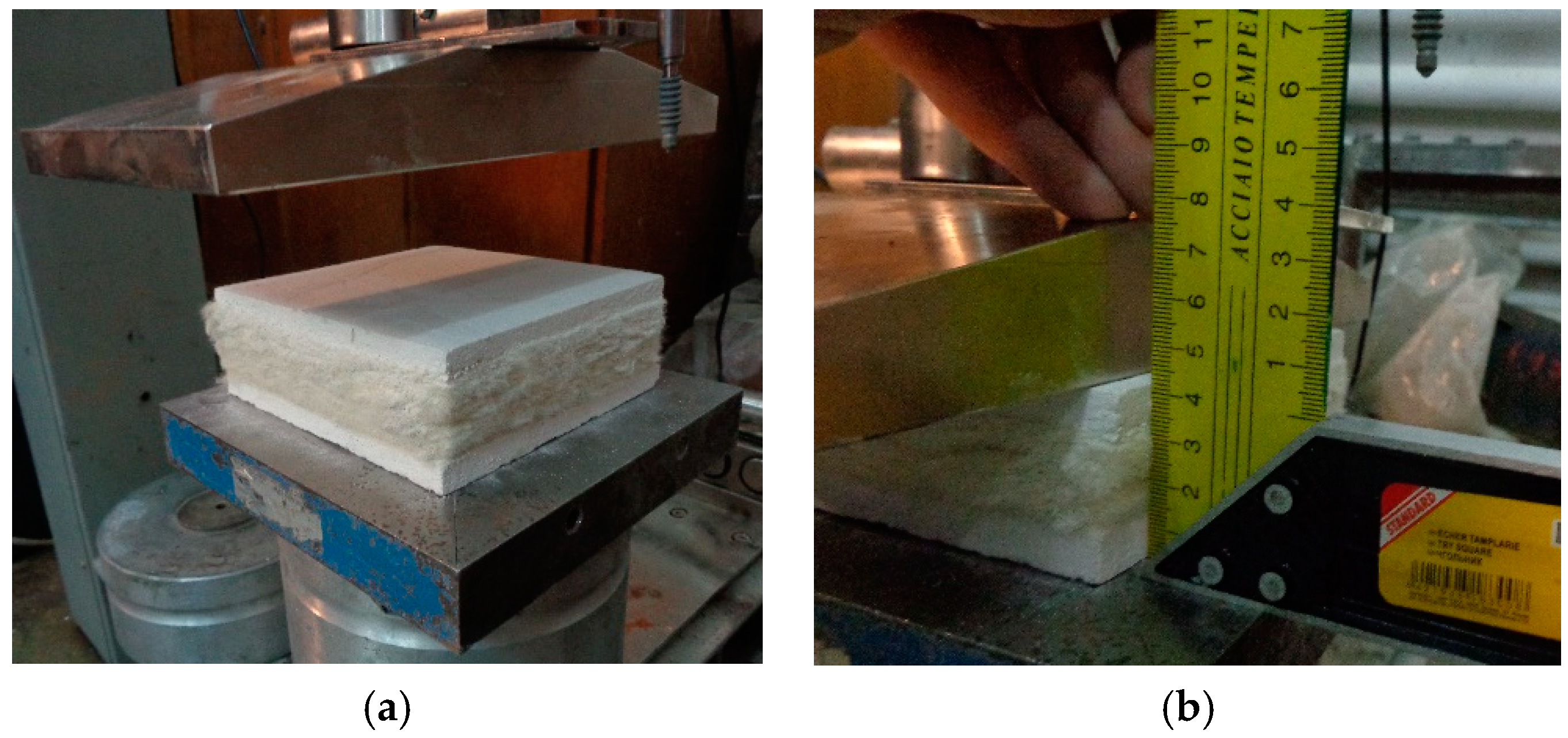

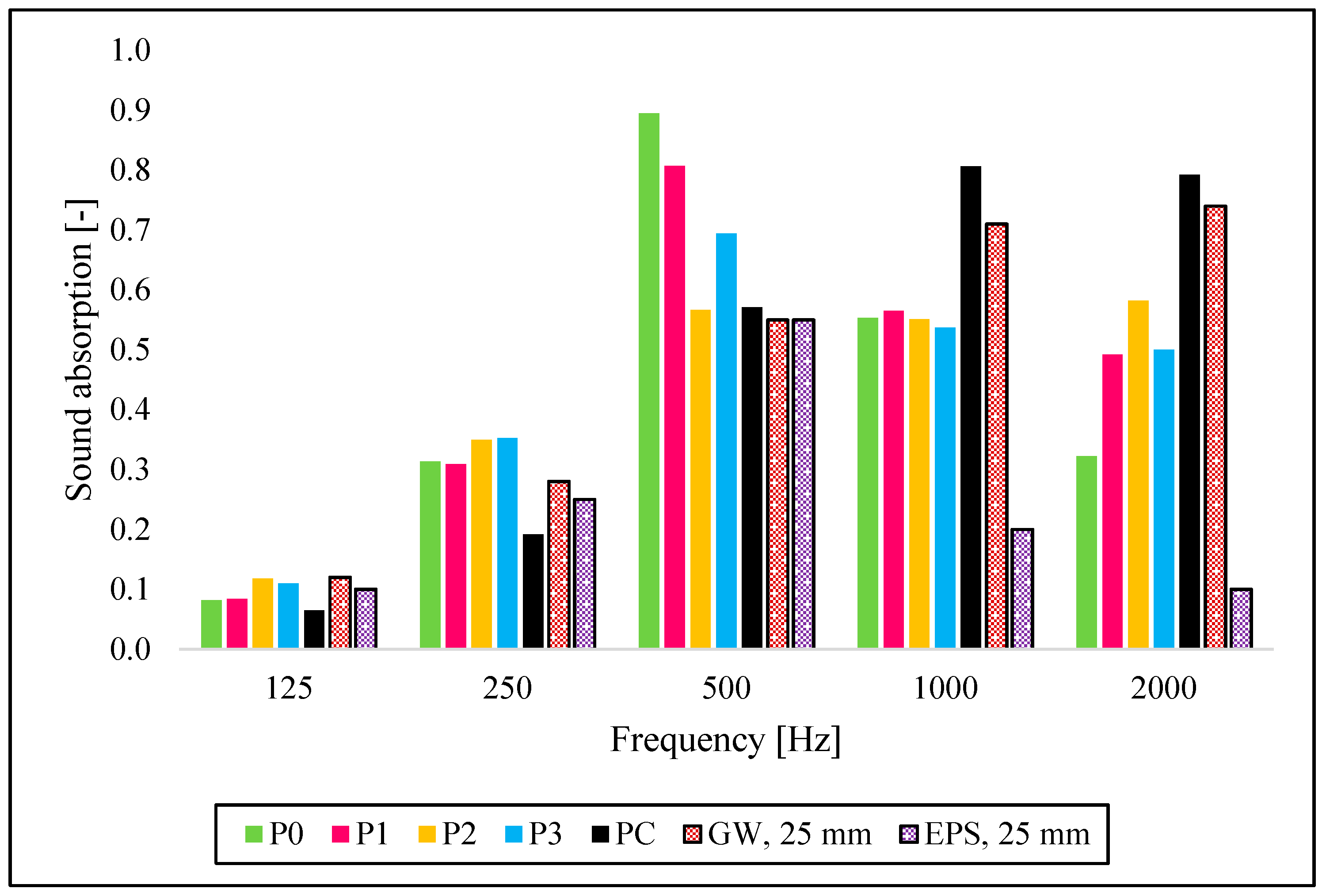

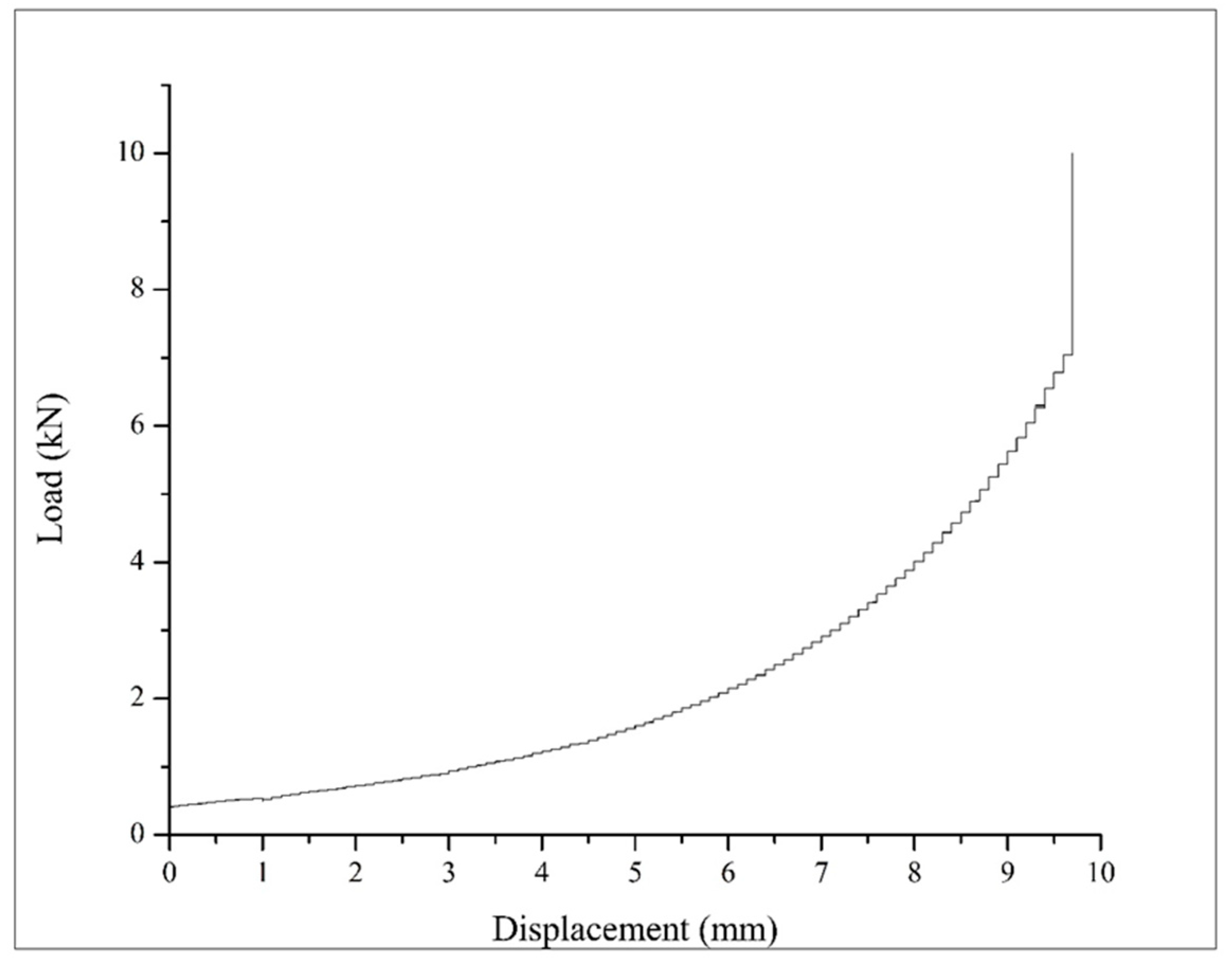
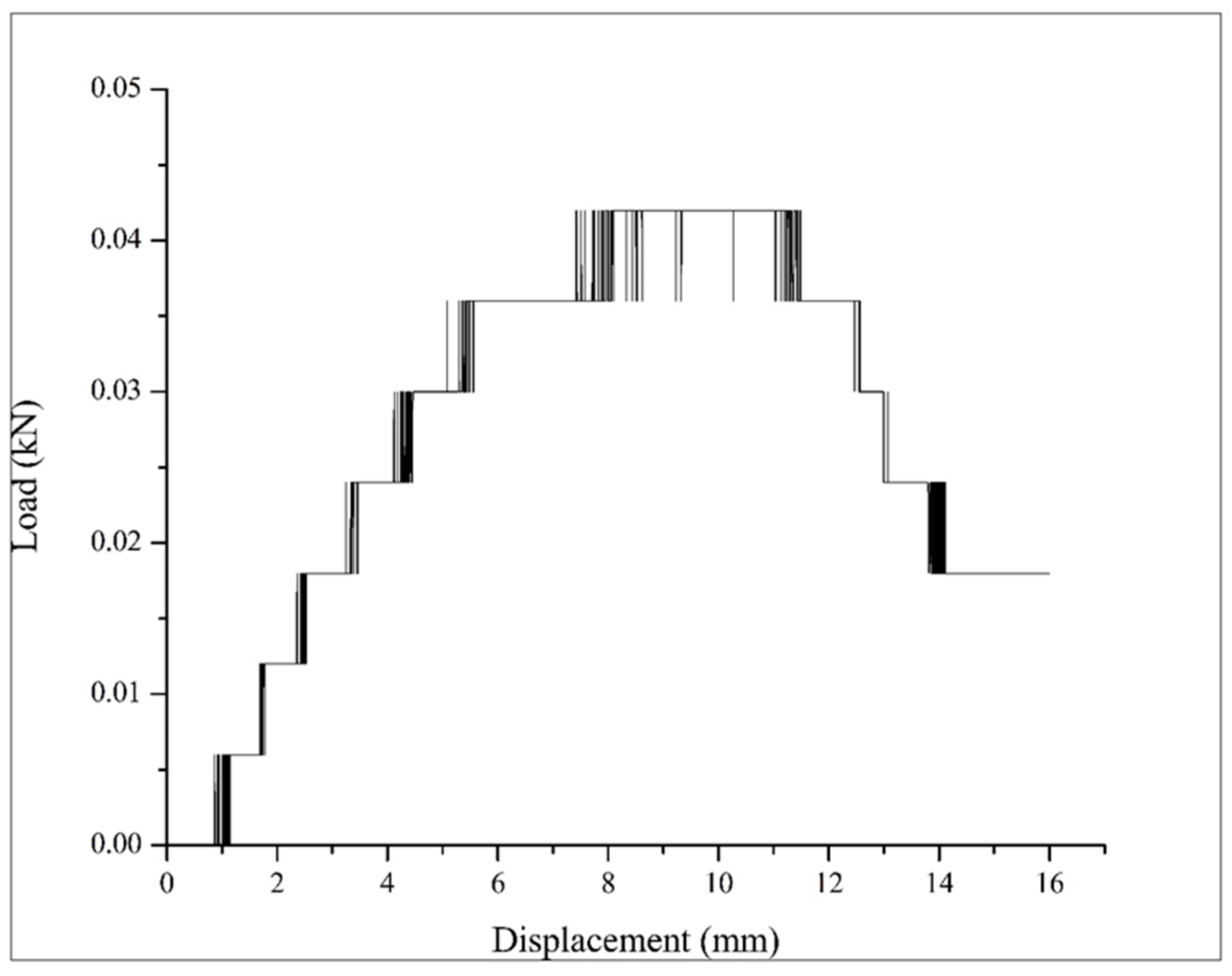
| Material | Rice Paste (g) | Hydrated Lime (g) | Wool Fibers (g) | Water (mL) | Wheat Flour (g) | |
|---|---|---|---|---|---|---|
| 1 | Face sheet | 821.1 | 2395.3 | 61.2 | 1317.5 | - |
| 2 | Core | - | - | 600 | - | - |
| Binder | - | 609 | - | 2878 | 263 | |
| Sample | P0 | P1 | P2 | P3 | PC | GW | EPS |
|---|---|---|---|---|---|---|---|
| NRC (-) | 0.521 | 0.543 | 0.512 | 0.521 | 0.590 | 0.57 | 0.275 |
| Parameter | Value |
|---|---|
| Thermal conductivity (W/m·K) | 0.07699 |
| Apparent density (g/cm3) | 0.546 |
| Thermal resistance (m2K/W) | 0.6056 |
| Temperature (°C) | 20 |
| Parameter | Value |
|---|---|
| Relative deflection of 10% (mm) | 5 |
| Applied load afferent to the relative deflection of 10% (kN) | 1.559 |
| Compressive strength afferent to the relative deflection of 10% (MPa) | 0.208 |
| Parameter | Value |
|---|---|
| Maximum load (kN) | 0.042 |
| Deflection (mm) | 7.5 |
| Distance between support edges (mm) | 250 |
| Bending strength (MPa) | 0.042 |
© 2020 by the authors. Licensee MDPI, Basel, Switzerland. This article is an open access article distributed under the terms and conditions of the Creative Commons Attribution (CC BY) license (http://creativecommons.org/licenses/by/4.0/).
Share and Cite
Tămaş-Gavrea, D.-R.; Dénes, T.-O.; Iştoan, R.; Tiuc, A.E.; Manea, D.L.; Vasile, O. A Novel Acoustic Sandwich Panel Based on Sheep Wool. Coatings 2020, 10, 148. https://doi.org/10.3390/coatings10020148
Tămaş-Gavrea D-R, Dénes T-O, Iştoan R, Tiuc AE, Manea DL, Vasile O. A Novel Acoustic Sandwich Panel Based on Sheep Wool. Coatings. 2020; 10(2):148. https://doi.org/10.3390/coatings10020148
Chicago/Turabian StyleTămaş-Gavrea, Daniela-Roxana, Tünde-Orsolya Dénes, Raluca Iştoan, Ancuţa Elena Tiuc, Daniela Lucia Manea, and Ovidiu Vasile. 2020. "A Novel Acoustic Sandwich Panel Based on Sheep Wool" Coatings 10, no. 2: 148. https://doi.org/10.3390/coatings10020148
APA StyleTămaş-Gavrea, D.-R., Dénes, T.-O., Iştoan, R., Tiuc, A. E., Manea, D. L., & Vasile, O. (2020). A Novel Acoustic Sandwich Panel Based on Sheep Wool. Coatings, 10(2), 148. https://doi.org/10.3390/coatings10020148








